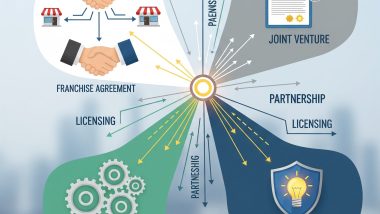When it comes to dining out, we often have a multitude of options, ranging from elegant restaurants to cozy cafes. These two dining establishments serve different purposes and offer unique experiences.
In this blog, we will look at the key differences between restaurants and cafes, as well as their respective pros and cons, helping you make an informed choice for your next meal out.
Definition of Restaurant and Cafe
What Is a Restaurant?
Restaurants are dining establishments that provide a wide range of culinary options, from fine dining to casual eateries.
What Is a Cafe?
Cafes are smaller, more relaxed dining establishments, often characterized by a cozier atmosphere and a focus on coffee and light meals.
Also Read: Innovative AI-Based Business Ideas to Transform Industries
Key differences between restaurants and cafes
Restaurants and cafes both differ in several key aspects, including their history, menu offerings, ambiance, service style, and the overall dining experience they provide.
Here are the primary differences between restaurants and cafes:
1. History:
The history of restaurants and cafes is a fascinating journey that takes us through centuries of culinary and cultural evolution. Here, we'll explore the origins and development of these two distinct dining establishments.
History of Restaurants:
- Ancient Origins: The concept of serving prepared meals for customers can be traced back to ancient civilizations. In ancient Rome, for example, there were establishments known as "thermopolia," where individuals could purchase hot food and drinks from vendors.
- France in the 18th Century: The term "restaurant" itself is of French origin and became more prevalent in the 18th century. The first true restaurant is often credited to Boulanger, a soup vendor in Paris, who in 1765, posted a sign that read "Boulanger sells restoratives fit for the gods and men." These "restoratives" were the precursors to the modern restaurant menu.
- The Evolution: Over time, restaurants evolved into establishments where patrons could sit down and order from a menu with a variety of dishes. The French Revolution played a significant role in the development of restaurants, as it led to an influx of chefs who had lost their noble patrons.
- Global Spread: The concept of restaurants eventually spread across Europe and the world. Each region added its own cultural and culinary twist, resulting in a wide range of restaurant types, from fine dining to casual eateries.
History of Cafes:
- Coffeehouses in the Arab World: The history of cafes is closely intertwined with the history of coffee. The first coffeehouses, or "qahveh khaneh," appeared in the Arab world, specifically in cities like Mecca and Istanbul, during the 16th century. These coffeehouses quickly became popular as gathering places for intellectual discussions.
- Europe in the 17th Century: Coffee was introduced to Europe in the 17th century, and coffeehouses began to appear across the continent. These cafes became known as places where people could socialize, discuss politics, literature, and philosophy, and enjoy the stimulating effects of caffeine.
- The Enlightenment Era: The 18th century, often referred to as the Age of Enlightenment, saw the proliferation of cafes across Europe, particularly in cities like Paris and Vienna. These cafes played a pivotal role in fostering intellectual and artistic movements.
- Evolution into Modern Cafes: As cafes continued to evolve, they started to serve not only coffee but also light meals, pastries, and other refreshments. This transition led to the modern cafe, characterized by its relaxed and comfortable atmosphere.
2. Menu Variety:
Restaurants:
- Restaurants typically offer a wide and diverse menu with a range of appetizers, entrees, desserts, and beverages.
- They often have specialized chefs who can prepare complex and intricate dishes.
- The menu can cater to various culinary preferences and dietary restrictions.
Cafes:
- Cafes usually have a more limited menu, focusing on coffee, tea, pastries, and simple light meals like sandwiches and salads.
- The emphasis in cafes is on simplicity and convenience, with a focus on a few signature items.
- The menu may be smaller and more focused on a specific theme or type of cuisine.
3. Ambiance:
Restaurants:
- Restaurants often provide a more upscale, formal, or thematic ambiance.
- They may feature elegant decor, mood lighting, and a specific atmosphere tailored to the type of cuisine they serve.
- Many restaurants are suitable for special occasions and romantic dinners.
Cafes:
- Cafes are known for their casual, relaxed, and cozy atmospheres.
- They typically have a more informal and welcoming decor, with comfortable seating arrangements.
- Cafes are often chosen for casual meet-ups, work sessions, or leisurely chats with friends.
4. Service Style:
Restaurants:
- Restaurants usually offer full table service, with dedicated waitstaff who take orders, serve meals, and attend to diners' needs.
- The service in restaurants is generally more formal and attentive.
Cafes:
- Cafes may offer counter service or minimal table service.
- Customers often place their orders at the counter, receive their food and drinks there, and may clear their tables themselves.
5. Price:
Restaurants:
- Dining in a restaurant tends to be more expensive, as you may be paying for the ambiance, high-quality ingredients, and the full-service experience.
- Restaurants are often chosen for special occasions or when looking for a more luxurious dining experience.
Cafes:
- Cafes are generally more budget-friendly, making them a popular choice for quick, affordable meals.
- They are suitable for those seeking a cost-effective dining option or a quick coffee and snack.
Also Read: How to Start Toys Manufacturing Business in India in 5 Steps!
Pros and Cons of Restaurant and Cafe
Here are some pros and cons of dining in a restaurant:
Pros:
- Varied Menu: Restaurants offer diverse menus with a wide selection of dishes to cater to different tastes and dietary preferences.
- Ambiance: Many restaurants create a sophisticated or thematic ambiance, making them suitable for special occasions and romantic dinners.
- Full-Service: Restaurants usually provide full table service, including dedicated waitstaff and more extensive drink menus.
Cons:
- Cost: Dining in a restaurant can be more expensive, as you may pay for the ambiance and higher-quality ingredients.
- Longer Wait Times: Depending on the restaurant's popularity, you might experience longer wait times for a table.
Here are some pros and cons of dining in a cafe:
Pros:
- Casual Atmosphere: Cafes provide a laid-back and comfortable setting, perfect for casual meet-ups, work sessions, or relaxing alone.
- Affordable: Cafes typically offer budget-friendly options, making them an ideal choice for those looking for a quick and inexpensive meal.
- Quick Service: Orders in cafes are often served quickly, making them great for those on the go.
Cons:
- Limited Menu: Cafes may have a limited menu, primarily focusing on coffee, pastries, and simple meals.
- Less Formal: If you're seeking a formal or special dining experience, a cafe may not be the best choice.
Also Read: Top 10 Secondary Income Sources in 2024
Which Is Best for Customers?
The choice between a restaurant and a cafe ultimately depends on your preferences and the occasion. Here are some considerations:
- Choose a restaurant for special occasions, fine dining, and when you desire an extensive menu and exceptional service.
- Opt for a cafe when you want a quick, casual meal, a cozy atmosphere for a catch-up with friends, or an affordable and relaxed dining experience.
In conclusion, both restaurants and cafes have their unique charm and serve distinct purposes. The best choice depends on your mood, the occasion, and your budget. Whether you prefer the refined experience of a restaurant or the laid-back ambiance of a cafe, both options offer delightful dining experiences for customers to savor.


















